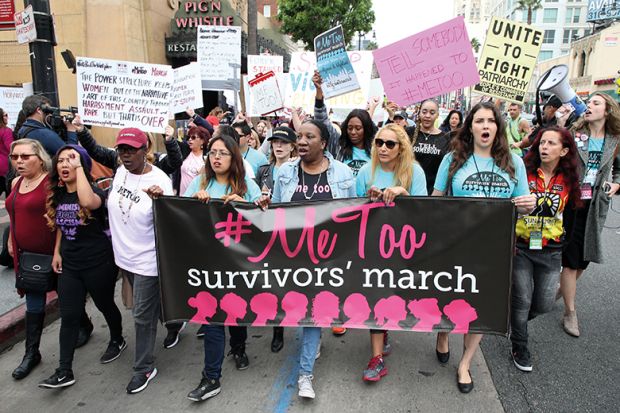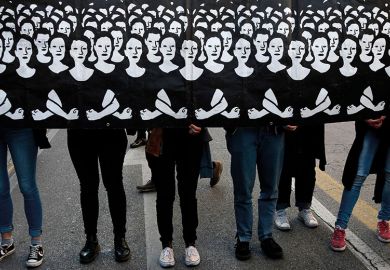The obvious way to introduce a title such as this is to comment on its timeliness. Obvious, but also inexact and somehow diminishing. For while its subject matter has recently been a topic of much discussion, with sexual harassment once again newsworthy in many parts of the world, the problems it addresses are in no way new.
Rebecca Hanson and Patricia Richards describe their initial intention to write about their own experiences of sexual harassment “in the field” – that is, while undertaking ethnographic research. They later decided to do “a few” interviews, eventually speaking with almost 60 researchers. Their cohort comprises mostly women and some men, the vast majority of whom belong to the precarious ranks of graduate students and early career researchers, housed predominantly within sociology and adjacent disciplines at US institutions. While more than half of interviewees are white and about three-quarters are straight, the authors give close consideration to intersectional dynamics, demonstrating how sexual harassment is often shot through with racist assumptions and heteronormative demands. Participant fieldwork sites span a range of geographical locations, divided equally between the global south and north.
Interviewees relay a litany of sexual power plays and discomfiting dynamics, from suggestive remarks, flirtatious banter and licentious touching through to subtle intimations, overt propositions and outright sexual bargaining. Some recount more concerted forms of abuse, including stalking, physical attacks and rape. Virtually all described being unprepared to deal with intimate intrusions in fieldwork, either in the moment or during its aftermath. Practical responses varied: some interviewees endured uncomfortable episodes for the sake of their research; others adapted their study design in an effort to secure their safety; a number abandoned their projects altogether. In written accounts, sexual harassment was generally relegated to the status of “awkward surplus”, a concept the authors borrow from Joan Fujimura to describe data that “doesn’t fit” and so is excluded.
Rather than attributing the problem of sexual harassment solely to the sites where it occurs, Hanson and Richards explore how it is animated and exacerbated by a persistent “methodological silence on harassment and sexualization”. While no method of social research is without risk, ethnography creates particular risks for women (and, in related ways, for trans people). Organised around a triad of “fixations” – namely solitude, danger and intimacy – it is generally understood as an individual undertaking based on deep immersion over a prolonged period, involving discomfort as a matter of course and peril in its most celebrated forms. Forged in the image of its earliest adherents – a distorted image, given the numerous wives who assisted their husbands in fieldwork – it continues to assume the white male body as its instrument, even after various reflexive turns.
One of the book’s major contributions is to lay bare the gendered character of ethnography as practical endeavour and intellectual pursuit. Interview extracts vividly convey how prevailing conventions create pernicious traps and impossible binds for female researchers, for whom the very act of entering a field site alone and unknown frequently contravenes prescribed norms of feminine conduct and so renders them vulnerable to overtures and advances. Gaining entry to established communities frequently gives rise to further problems, as attempts to cultivate relationships are misread – innocently or maliciously – as expressions of sexual availability. The need to maintain access and pursue further opportunities where they arise too often acts as a shackle, keeping women in situations they know to be unsafe. Informants attuned to this need can too easily leverage it towards their own ends, employing tactics of manipulation and misdirection.
To be clear, it is not that men are somehow exempt from risk; indeed, men are more likely to suffer physical harm, in ethnographic fieldwork as in everyday life. Rather, it is that ethnography as currently conceived entails risks for women that are specifically sexual in nature. Moreover, while physical suffering can serve as a mark of serious and committed research, there is no glory in sexual suffering. Instead, a generalised silence prevails, communicating, as Hanson and Richards put it, that “harassment and violence are not proper subjects to discuss in relation to methods”.
The book’s main argument centres around the authors’ call for an embrace of “embodied ethnography”, beginning from the recognition that “all knowledge is embodied” and further maintaining that “paying attention to what happens to our bodies in the field is a form of data collection”. Methodological literature must integrate rather than ignore experiences of sexual harassment in fieldwork, and methodological training must address this potentiality and elucidate its implications for knowledge production. Although it is not possible to eliminate the risk of sexual harassment entirely, it is possible to create institutional structures through which its occurrence might be anticipated and its worst effects alleviated. Embodied ethnography, then, is not “the solution”, suggest Hanson and Richards, but rather “one of multiple (and imperfect) projects that seeks to alter how academics produce and evaluate knowledge”. Doubling down on this point, they contend: “Disembodied ethnography…is one of the wrong ways to do ethnography.”
I am largely supportive of these arguments: of course it is important for researchers to consider how our embodiment shapes our research and therefore informs the knowledge we produce. I also agree that experiences of harassment can be used, as the authors suggest, to illuminate social dynamics and as such should rightly be regarded as important data. At the same time, I wonder about the additional demands that this places on researchers, and on some researchers more than others. In particular, I am wary of any suggestion that those who experience sexual harassment in fieldwork might have a duty to tell of their experiences, whether for the edification of other researchers or as a matter of methodological principle. To speak of sexual harassment – to elucidate the sense of irritation or terror or grim recognition it inspires – is necessarily to invite others into that moment, to imagine and participate in it. And while some will be empathetic, others will be doubtful, disinterested or disparaging.
Here I come, inevitably, to the “timeliness” alluded to earlier: the recent global phenomenon that is #MeToo. As a mobilisation against sexual harassment, #MeToo relies on what Tanya Serisier terms “narrative politics”, whereby speaking out is understood as a crucial means of ending violence. By talking about our experiences, it is assumed, we can go some way towards eliminating them from the world. And yet, while speaking out can be vitally important for those who experience harassment and abuse – providing catharsis and solidarity – decades of talking about sexual violence have not reduced its incidence. By this understanding, #MeToo is not the watershed moment it is widely believed to be, but instead represents a continuation of long-standing efforts whose ultimate promise has not been fulfilled.
As the book’s bibliography attests, the problem of sexual harassment in fieldwork is not new, nor has it gone undiscussed: feminist scholars have been talking about these issues since at least the 1980s. While positioned as a challenge to institutional silence, Harassed could instead be seen as throwing down the gauntlet, providing a comprehensive appraisal of the problem and setting out clear-headed proposals for change. The crucial question now – as with the wider #MeToo movement – is of who will hear and heed this message. My hope is that this book will be read widely, most especially by those who know little about the realities it documents. The one caveat I offer is that, although it is crucial to cultivate spaces to speak, the prerogative to decide if and how and when to tell must remain a key pillar of feminist organising against sexual violence, within the academy and without.
Rachel O’Neill is a research fellow in sociology at the University of York and the author of Seduction: Men, Masculinity and Mediated Intimacy (2018).
Harassed: Gender, Bodies and Ethnographic Research
By Rebecca Hanson and Patricia Richards
California University Press
240pp, £70.00 and £25.00
ISBN 9780520299030 and 9780520299047
Published 29 May 2019
The authors
Rebecca Hanson, assistant professor in the Center for Latin American Studies and the department of sociology and criminology and law at the University of Florida, was born and spent her early years in Alabama. She studied at the University of Montevallo, also in Alabama, and it was there, she says, that she “initially fell in love with sociology and ethnography. My doctoral programme at the University of Georgia provided me with a unique opportunity to learn from a group of experienced ethnographers in the sociology department and to complete a specialisation in qualitative research, which provided a solid basis for learning both the epistemology and the practice of qualitative methodology and methods.”
Patricia Richards, Meigs professor of sociology and women’s studies at the University of Georgia, was born and raised in Wisconsin. She did her first degree at the University of Wisconsin, where, she recalls, she “had the opportunity to work with sociologists…who supervised my first independent foray into ethnographic fieldwork when I studied abroad in Ecuador during my junior year”. Going on to do graduate work at the University of Texas at Austin, she “benefited from strong Latin Americanist, feminist and qualitative training”, with mentors who “really stressed asking hard questions, recognising how the academy can reproduce inequality and doing critical work to counter that”. Such training, she believes, “really informs our work” on Harassed.
Asked about why they devoted their new book to the comparatively neglected topic of harassment “in the field”, the authors reply that “We began working on harassment in the field after discussing the consistent harassment Rebecca was facing while conducting her dissertation research…As we argue in the book, androcentric, racialised and colonialist standards turn researchers’ embodied experiences into ‘awkward surplus’ and silence women researchers when they face sexual harassment and violence in the field.”
Matthew Reisz
POSTSCRIPT:
Print headline: The ‘awkward surplus’ of unwanted attention
Register to continue
Why register?
- Registration is free and only takes a moment
- Once registered, you can read 3 articles a month
- Sign up for our newsletter
Subscribe
Or subscribe for unlimited access to:
- Unlimited access to news, views, insights & reviews
- Digital editions
- Digital access to THE’s university and college rankings analysis
Already registered or a current subscriber?




